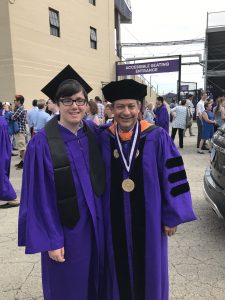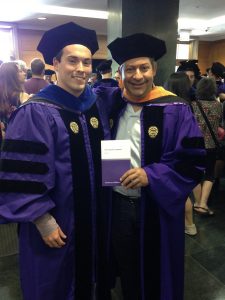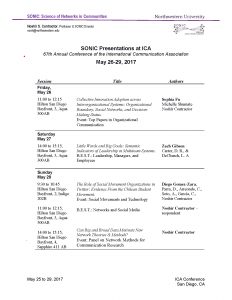Noshir Contractor gave a plenary talk in a session titled “Organizing and Organizations” at the Collective Intelligence Conference. CI is the fifth annual interdisciplinary conference dedicated to advancing our understanding of collective intelligence and the workings of groups. The conference took place at New York University’s Tandon School of Engineering in Brooklyn, NY, on June 15-16, 2017.
Congratulations to Brennan Antone for graduating with a BS and starting the Ph.D. program !!!
Congratulations to Brennan Antone for graduating with a BS in Industrial Engineering & Management Sciences (IEMS) and a minor in Psychology at Northwestern and joining the Ph.D. program in IEMS at Northwestern this Fall. Welcome back!!!

Congratulations to Dr. Aaron Schecter for graduating and starting a faculty position!
Congratulations to SONIC member, Dr. Aaron Schecter for graduating with a Ph.D. in Industrial Engineering & Management Sciences at Northwestern and starting as an assistant professor in the Department of Management Information Systems at the Terry College of Business, University of Georgia!!!

Noshir conducted a workshop at the 2017 SciTS Conference
Noshir Contractor was a lead facilitator of a workshop at the Science of Team Science (SciTS) Conference in Clearwater Beach, FL, held on June 12-14, 2017.
Network Perspectives to Understand and Enable Team Science
Description: In this workshop, attendees will be introduced to the basics of social network theories, methods, and tools. They will come away with an improved understanding of the various forms of networks necessary for effective scientific collaborations. This workshop is organized into three distinct parts. (1) The first part provides an historical overview of the motivations to view team science from a social networks perspective. This first part will conclude with a brief introduction to the concepts of social networks, cognitive social networks, knowledge networks, cognitive knowledge networks and their relevance to team science. (2) The second part focuses on using network metrics to describe team science. This part begins by defining various concepts used in network analysis: actors and attributes of actors, relations and properties of relations as well as two-mode networks. Next it describes various how these concepts influence strategies for the collection of network data. The session then defines and describes how various common network metrics are computed and interpreted at the actor, dyadic, triadic, sub-group, and component level. (3) The third part of the workshop addresses using network models to understand and enable team science. Here, a multi-theoretical multilevel (MTML) model is outlined to help stakeholders understand the dynamics for creating, maintaining, dissolving, and reconstituting social and knowledge networks in scientific communities. The session will provide a high level overview of statistical techniques to test MTML models of team science. Research exemplars are presented to illustrate the potential of the MTML framework to understand and enable team science. The session concludes with a demonstration of how these insights are being used to develop recommender systems for assembling effective scientific teams.
Congratulations to Sophia Fu, Michelle Shumate, and Noshir Contractor for a top paper award!
One of the SONIC papers, presented at the 67th Annual Conference of the International Communication Association (ICA) on May 25-29 in San Diego, CA., received a Top 4 Paper Award in the Organizational Communication Division.
Fu, Sophia, Shumate, Michelle, & Contractor, Noshir. Collective Innovation Adoption across Interorganizational Systems: Organizational Boundary, Social Networks, and Decision-Making Status.
SONIC papers presented at the XXXVII Sunbelt Conference in Beijing, China.
Nebula – a finalist for the IMS Global Consortium Learning Impact Award
Nebula was selected as a finalist for the IMS Global Consortium Learning Impact Award that was held on May 16-19 2017. Most of the competition was professional educational tech applications. See the full list of Winners of the 2017 Learning Impact Awards here, where Nebula is listed among the 2017 Honorable Mentions.
Congratulations to Jackie Ng and Noshir Contractor – SONIC contributors to Nebula!
Nebula is a Northwestern alternative to the standard Canvas discussion board. Nebula is a hybrid type of learning tool that at once offers analytic visualization of complex discussion dynamics and invites participation in that dynamic by having users contribute posts and comments directly to the discussion graph. Its visual approach is very intuitive to understand and use, promoting more rapid and frequent student engagement in the discussions.
https://vimeo.com/213856028
Diego Gomez-Zara wil present at ICA 2017
On May 28th, the Ph.D. student Diego Gómez-Zará presented his research on social movements at the 67th conference of the International Communication Association (ICA). This year, the conference was hosted in San Diego, USA. Diego presented on “The Role of Social Movement Organizations in Twitter: Evidence From the Chilean Student Movement.” By using a mixed-methods approach, incorporating network analysis, sentiment analysis, and content analysis, the study identifies differences in how social movements’ information flow, network position, and attitudes evolve.
Leslie DeChurch will present at the Mars Mission Social Sciences Workshop
On may 30th, 2017 Leslie DeChurch will present at the Mars Mission Social Sciences Workshop at the Buzz Aldrin Space Institute in Cape Canaveral, FL. The title of her paper, co-authored with Noshir Contractor and Michael Schultz, is SCALE: Shared cognitive architecture for long-term exploration.
SONIC members presenting at the 2017 ICA in San Diego, CA
Noshir Contractor and two SONIC graduate students: Diego Gomez Zara, and Zachary Gibson are going to present at the 67th Annual Conference of the International Communication Association (ICA) on May 25-29 in San Diego, CA.
One of the papers, co-authored by Noshir Contractor, will be presented at the Top Paper Panel for the Organizational Communication Division:

